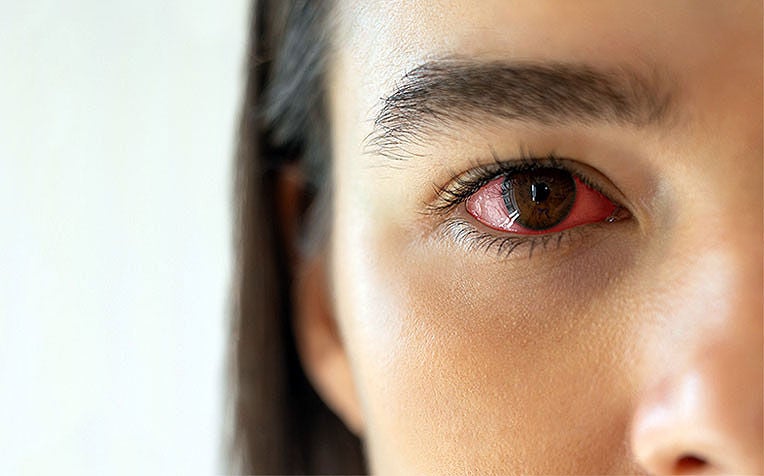
Red eye may appear alarming at first, but in many cases tends to go away on its own after a few days to a week. However, if the condition persists longer, do consult an ophthalmologist for further evaluation.
Sometimes you wake up and find yourself with a sore eye, making the start of your day a bad one. It might cause irritation or even pain, so what is this symptom?
Known as ‘red eye’, this occurs when the blood vessel near the surface of the eye becomes inflamed due to infection or irritation. It will go away on its own after a few days to one week.
However, if your eye remains red after one week or you experience eye pain, blur vision, itchiness or swelling, you should consult an ophthalmologist for further evaluation, says Dr Ong Hon Shing, Consultant from the Corneal & External Eye Disease Department at Singapore National Eye Centre (SNEC), a member of the SingHealth group.
While red eye will usually resolve on its own, here are some steps you can take to help relieve the discomfort.
How to relieve red eye
1. Use warm compress
Place a warm, damp washcloth over your infected red eye for about 10 minutes. This helps to sooth your eye and may make it feel better right away.
A warm compress not only helps to relieve the grittiness that is caused by dry eye, it also helps to relieve the inflammation on the eyelids and discomfort from eye infection.
2. Use eye drops
Artificial tears offer relieve for dry and irritated eyes and can be purchased easily over the counter at the your local pharmacy.
3. Practise hand hygiene
Wash your hands frequently and avoid touching your eyes or the surrounding areas if your hands are not clean.
4. Avoid makeup or contact lens
You should not put on makeup or wear contact lens if your eyes are still red and should only start to do so when the symptom goes away.
5. Limit screen time
Spending too much time reading a book or staring at your digital device can result in dry eye and eye strain. Try to take a vision break every 30-40 minutes by looking at an object 20 metres away for 20 seconds and blink your eyes more often.
4 Easy ways to prevent red eye
You can prevent red eye from occurring by following proper hygiene and avoiding irritants that cause redness in the eye.
Never put on your contact lens longer than recommended or leave it on overnight
Wash your hands frequently especially when you have close contact with someone who is having red eye
Remove makeup from your eye properly every day
Avoid rubbing your eye. Your eye may become red and irritated from the dirt on your hand and fingers
Common causes of red eye
Red eye can be caused by several factors and the most common ones are as follows:
Conjunctivitis
Conjunctivitis or ‘pink eye’ occurs when the conjunctiva, the thin translucent tissue that lines the white part of your eye, becomes inflamed due to a virus or bacteria.
Viral conjunctivitis will commonly recover on its own but may take about two to four weeks.
Bacterial conjunctivitis, on the other hand, can be treated using antibiotic eye drops. Both types of infection are contagious and spreads easily. So remember to wash your hands frequently and avoid sharing towels/pillows etc.
Dry eye
Dry eye happens when your eyes do not produce enough tears to lubricate the surface, and your eye becomes red, painful, and stinging. Adequate tears are necessary to keep your eyes healthy and comfortable.
Dry eye is more common in people who are aged 50 years and above; reading or staring at a computer screen or digital device for prolong period and failure to blink the eye regularly; on certain types of medication or wearing contact lenses for a long time or in people who had previous laser vision corrective surgery.
Allergies
Allergy occurs when your immune system reacts to a foreign substance such as pollen, pet dander, dust or certain chemicals found in contact lens solution or makeup. Your eye becomes red, watery, and itchy as the blood vessels in the eye enlarge due to the histamines release by your body to fight off the allergens.
Blepharitis
Blepharitis a common condition that occurs due to the inflammation of the eyelids, affecting the edges (margins) of the eyelids and causing irritation, redness, aggravating dry eye, flaking of the skin around the eyelids and crusting of the eyelids.
It can be uncomfortable, but it usually will not cause any damage to your eyesight, and it is not contagious.
Acute angle-closure glaucoma
Angle-closure glaucoma can either be acute or chronic. It is characterised by a sudden, dramatic increase in intraocular pressure, and cause severe eye pain, redness, blurred vision, and the appearance of haloes around lights.
This requires prompt treatment at an emergency department to avoid vision loss.
Eye injury
An eye injury can cause your eye to become red and bloodshot. When the eye is injured, the blood vessel in your eye enlarge to allow more blood and cells to repair the injury.
Common causes of eye injury include scratches on the cornea, bleeding in the eye resulting from straining, sneezing, or coughing too hard. More serious injuries can result from sharp objects, sports injuries, or strong chemicals / heat.
Improper use of contact lenses
Eye infections arising from contact lens wear can be due to using extended-wear lenses; sleeping in your contact lens; bacteria or fungi and improper care of contact lenses. This often irritates your eye and causes it to become red. Certain contact-lens infection can cause serious vision loss or even blindness if left untreated.
After reading this article, you should have a better idea of how to prevent red eye, and what to do when it happens. Besides you and your loved ones, EYEcare about your eye health as well! Get it? :)
Ref: J22
Check out other articles on eye care:
11 Easy Ways to Maintain Good Eyesight
8 Ways to Prevent Computer Eye Strain
Cataract: Causes, Symptoms and Treatment
Glaucoma: 4 Ways to Prevent the 'Silent Thief of Sight'
AMD (Age-Related Macular Degeneration): What You Need to Know
Contributed by


















 Get it on Google Play
Get it on Google Play